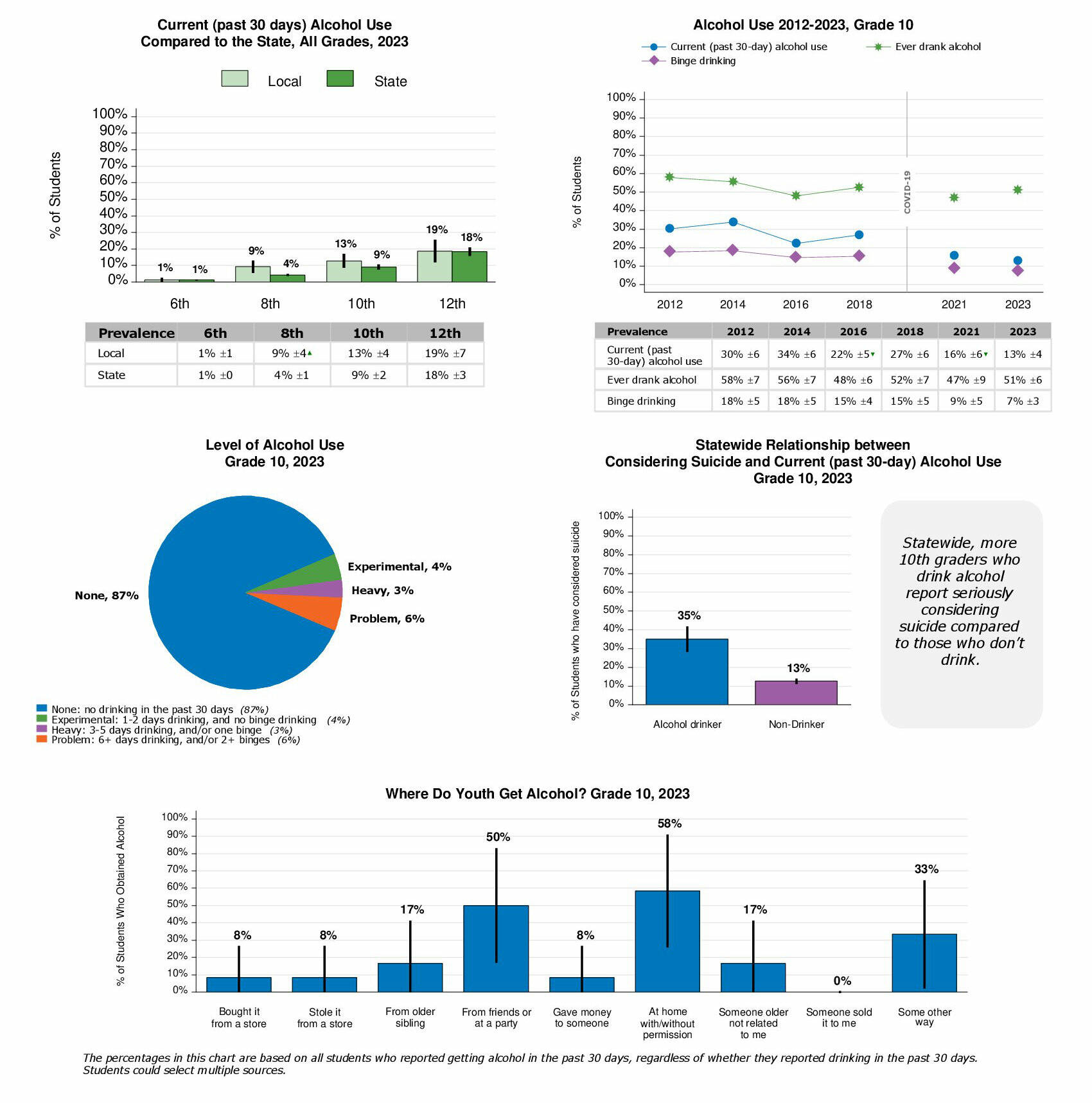Washington State’s biannual Healthy Youth Survey is normally only broken down to counties.
But The Courier-Herald recently received data about Enumclaw School District’s results, which details how 6th, 8th, 10th, and 12th graders perceive school safety and bullying, perceive and use substances, how they feel about positive teacher interactions and hopefulness, and much, much more.
The 211-page documents was provided by the Enumclaw School District.
Before going into the data, there is one note to consider for accuracy: not all students participated in the study. Only about a quarter of total students answered questions on substance use, and just about half of the total senior population participated in this particular portion of the survey.
SUBSTANCE USE
Alcohol
One of the major purposes of the Healthy Youth Survey is to track substance use among students.
Alcohol use is minimal for 6th graders, and an average of 8% of 8th graders reported having used alcohol within 30 days of taking the survey between 2012 and 2023; that’s five points higher than the state average.
An average of 28.5% of 10th graders reported drinking alcohol within the last 30 days between 2012 and 2018. That decreased to 16% in 2021, and dropped again to 13% last year. That’s four points more than the state average
Senior alcohol use has taken a large dip, from an average of 40% between 2012 and 2018 to 19% last year, which is about on par with the state average.
Tobacco/vaping
While it seems fewer students are drinking, there may be a pattern of increasing tobacco and vape use.
Tenth grade reports of vape use in last 30 days skyrocketed from 18% in 2016 to 39% in 2018. That dropped to just 10% in 2022, but rose to 15% last year.
It’s harder to determine the pattern for seniors, as not enough students participated in the 2021 study. Vape use in the last 30 days jumped from 26% to 38% from 2016 to 2018, but has since fallen to 17%. However, the HYS notes that this 17% was up seven points from 2021, even though the data for that year is suppressed.
Marijuana
Marijuana use in among 8th and 10th grade students in the last 30 days appears to be holding steady; the former consistently stays around 8%, and the later around 30%, give or take a few percentage points.
Senior marijuana use dropped from a 2012-2018 average of 19.5% to 7% in 2021, but rose again to 12% last year.
VIOLENCE AND SAFETY
Feeling safe
The vast majority of 6th graders reported feeling safe at school between 2012 and 2023, but between 10% and 20% of 8th graders reported not feeling safe. Additionally, 10% of 8th graders reported missing school because they felt unsafe.
The number of 10th graders feeling unsafe at school has been steadily rising for 10th graders, from 12% in 2012 to 21% in 2018, and has stayed at that level for the 2021 and 2023 surveys. The report notes that 7% of 10th graders reported missing school for this reason.
Seniors generally feel safe, with only an average of 14% reporting feeling unsafe between 2012 and 2018. That has risen to 18% in this survey. No seniors reported missing school because of this.
Bullying
Bullying seems to be an issue at all ages, though more so in the younger grades than among freshman and seniors.
Twenty five percent of 6th graders reported that they were bullied, but that’s down from the 37% reported in 2021.
And while 29% of eighth graders reported bullying, they also reported that teachers are highly involved (84%) in intervening.
Twenty-four percent reported bullying via social media, phone, or video games; 20% reported receiving sexual images and video; 18% reported being harassed for their sexual orientation; and 17% reported bullying because of their race.
Numbers start to decrease in 9th grade: 21% reported bullying, but again reported high (44%) teacher intervention; 14% reported social media bullying; 17% said they have received sexual materials; and 13% and 8% reported harassment because of sexual orientation or race, respectively.
For seniors, 14% reported bullying and 84% reported teacher intervention; 11% reported social media bullying; 18% reported receiving sexual material; 18% reported harassment due to sexual orientation; and 11% reported harassment due to race.
PROTECTIVE FACTORS
The Healthy Youth Survey is not all doom-and-gloom, and also reports positive metrics like school and family protective factors — a.k.a. ways students feel good about school involvement and interactions with their parents.
For example, the vast majority (79%) of 6th graders report that their teachers praise them for good work, and another 57% report that their teacher contacts their parents as well.
And as for family protective influences, despite the stereotypes, 81% of seniors report being able to discuss their problems with their parents, and that between 90% and 100% of students reported that their parents believe substance use (cigarettes, marijuana, drinking, etc.) is wrong. According to the HYS, this is an effective preventative measure when it comes to youth substance use.
Maybe the most positive survey the HYS performs is asking students about hope.
Despite rising mental health issues, the vast majority (between 70 and 75%) of all students reported feeling “moderately” or “highly” hopeful.


